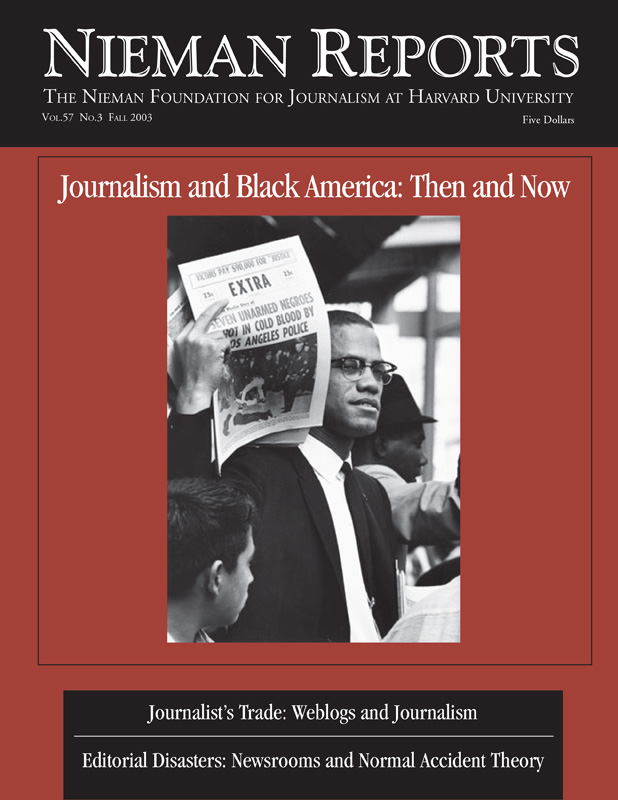In its report to the publisher of The New York Times, the Siegal Committee declared that the “practical result” of its recommendations “should be a guarantee that never again can a rogue journalist exploit our disconnectedness, or our failure to share warning signs.” “Never again” are extravagant words for journalists. But let us assume the committee is correct and the problem of the rogue journalist has been solved. Have others been created? Normal accident theory provides an answer.
After the disastrous experience with Jayson Blair, the paper’s management realized that its problems were broader and deeper than those posed by a troubled young man. The mandate of the Siegal Committee, which took its name from its chair, Assistant Managing Editor Allan M. Siegal, and included 21 other staff members and three outside journalists, was to recommend improvements for “the newsroom’s methods of communication, collaboration and supervision.”
The Siegal Committee was not the only body at work on these issues. There was also a working group on training and performance management and a communications group divided into three subcommittees. All told, these panels produced, by my count, well over 100 recommendations. These included generic wish items such as brown bag lunches, obvious steps like having job applicants interviewed by departments where they are likely to work, the strengthening of general principles, such as making accuracy a “higher priority” and narrow, specific suggestions, such as the Duke Corporate Education program.
Some of the recommendations from the various committees overlap, but even so, they constitute a bulk that even the Times can scarcely digest. Bill Keller, the executive editor, has wisely selected a few on which he can deliver, such as the appointment of an ombudsman and a masthead-level editor for upholding standards and another essentially for personnel matters.
Whether all of the recommendations would improve the Times is problematic. Much is made in the reports of the need to modify the culture of the Times. I would observe that a newspaper is a product of its culture, and if the culture at the Times is changed, the paper inevitably will also change and in ways that no one now can foresee.
Moreover, the Times is likely to find that a big obstacle to reform is simple inertia. The Siegal Committee noted that the Times relies too heavily on anonymous sources. That, by the way, is not a problem that requires a long lead-time for fixing. Try, beginning right now, declaring that nonconforming stories don’t get in the paper.
The Siegal report was released while I was out of the country. The first Times I read upon returning was published Saturday, August 9. A front page story on the mysterious trailers found in Iraq and suspected of being used for biological weapons contained at least a dozen anonymous statements. (The only person named, a spokesman for an intelligence agency, declined to comment.) Another Page One story on Liberia contained nearly as many. The notorious October 30, 2002 sniper story by Jayson Blair, given special notice by the Siegal Committee, contained five unidentified sources.
Business as usual? Rome wasn’t built in a day? Old habits die hard? Pick your cliché, but remember that identifying a problem and solving it are very different. In any event, my main purpose here is not to analyze the Siegal report and the others but to look at their recommendations in light of normal accident theory.
What Normal Accident Theory Suggests
The first thing to note is that organizations at risk of normal accidents are characterized by interactive complexity. Every newspaper is a complicated organism, and the Times would seem more complicated than most. If even a quarter of all the recommendations are put in place, the paper’s complexity will grow and with it the chance not only for things to go wrong but for the problems to spread in unpredictable ways.
Imagine a family car that has just put its occupants through a terrifying experience. First the brakes failed, then the steering locked up, and mysteriously the accelerator jammed. But instead of taking care of these three items, the family decides to have the entire car overhauled. The new, improved car not only has different brakes, steering and accelerator hookup, but it also has a new and untested fuel system, transmission, airbags, windshield wipers, headlights, suspension, the works—everything assembled not with factory components but with parts designed by committees of mechanics of varying qualifications and experience. Would you feel safer in it?
Secondly, normal accident theory teaches that disasters often begin with safety mechanisms. The catastrophe at Chernobyl started when engineers disconnected automatic shutdown devices to test the backup power system. Astronauts demanded safety devices for their Mercury spacecraft, and an escape hatch was added. But it was the accidental blowing of the hatch that set off a complicated system accident that led to the loss of the second Mercury capsule. As Scott D. Sagan notes, normal accident theory asserts that redundancy, added to systems for reliability and safety, “tends to add to the complexity and opaqueness of the system, thereby increasing the probability of hidden interactions ….”
Many of the committees’ recommendations make good sense. As a result of them, the Times may become an even better paper and a happier place to work. But complexity has been added often, I suspect, without consideration of the system as a whole. As a result, one may wonder whether the possibility of hidden interactions with unhappy consequences has now become a probability.


